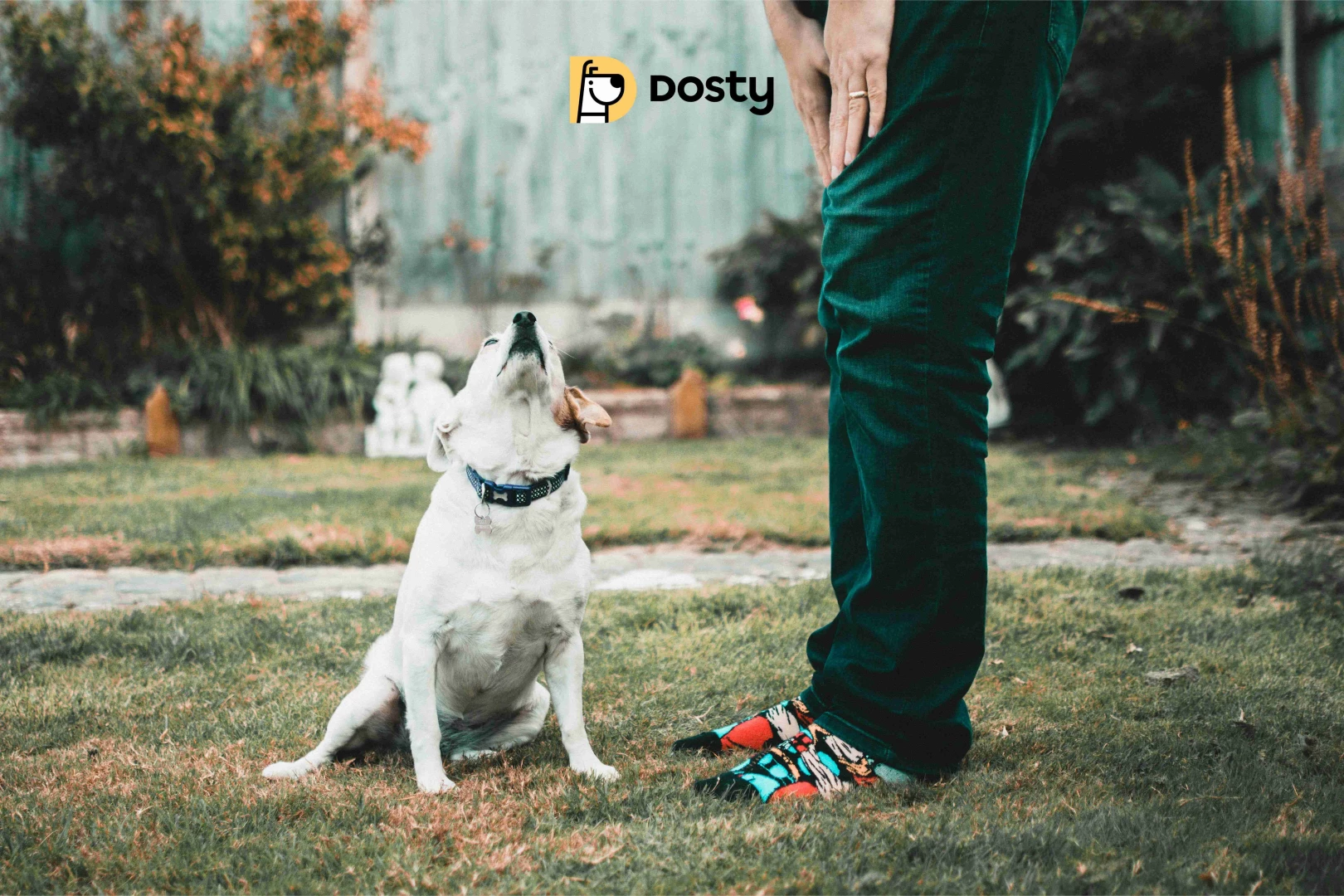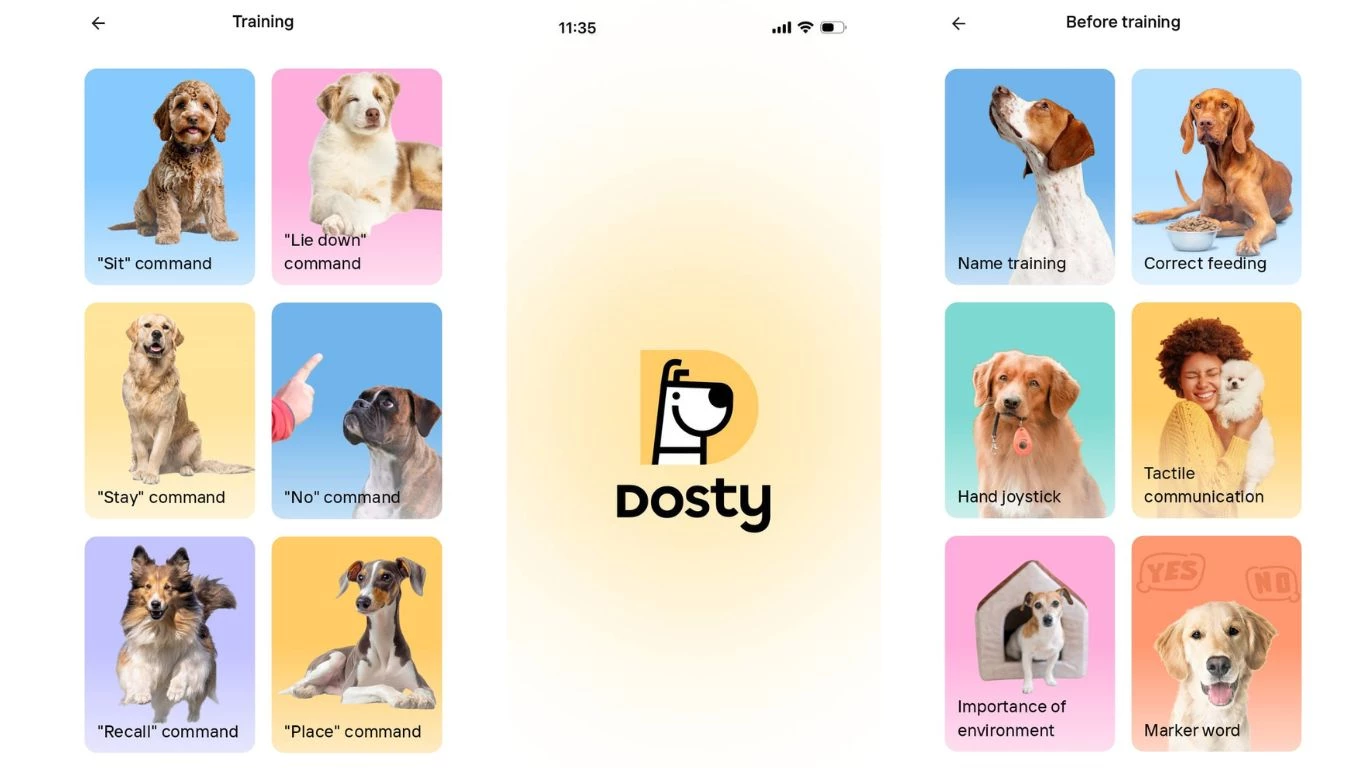On this page
Step-by-Step Guide to Dog Training: Teach “Come” Command in 5 Mins
One of the most important skills to teach any new dog is the “come” command. It's a safer and more stylish way for you and your pet to travel and a great value when boarding a pet. It allows your pet to move in a way that is natural to them, it can reduces anxiety and helps pet stay safe when traveling. In a 2024 report released by the Association of Professional Dog Trainers (APDT), more than 75% of outdoor dog incidents stem from bad recall.
No matter where you are, whether you call Toronto, London, New York, Sydney, remember that training can save your dog from cars, fights, or getting lost. “A well-taught recall can make a life and death difference,” says Dr. Andy Roark, DVM.
Prefer safer strolls and immediate recall❓
Use Dosty App’s pre-built training guides to train the “Come” command step-by-step, from recall to “stay”, it’s all visual, easy and trackable.
🎯 Work out smarter, better with Dosty.
Why Teach the Dog “Come” Command?
The “come” command establishes trust and control. It’s safety and freedom, not just obedience. Dogs who come when they’re called can be given more freedom under supervision and are more easily controlled in an emergency.
According to Dr. Ian Dunbar, Ph.D., BVetMed, “A reliable recall gives owners peace of mind and dogs a better life in a human world. Without that, even dogs who walk perfectly on a leash may bolt, not listen to their owners, or even do something dangerous.
The importance of training the dog to come:
- Safer off-leash play.
- Simplified vet and grooming visits.
- Deeper connection with positive interaction.
Start early if possible. Puppies catch on fast, but adult dogs can learn this, too, with repetition.
Explore blogs, breed insights, and expert advice on Dosty.co!
What Do You Need to Train a Dog to Come?
You don’t need much equipment to teach the “come” command to your dog, but what you do need is a good mentality.
Dog Command Training Essentials:
- High-value treats (chicken, liver or cubes of cheese).
- A 6- to 15-ft training leash or long line.
- Space efficient with no distractions for training.
- A cheerful, consistent voice.
- Optional: clicker for accurate marking.
Dog Command Training Mistakes to Avoid:
Effortless scale or negative body language.
Punishment for slow response.
Long workouts, make it short and sweet.
Got treats and a leash❓Let Dosty App do the rest❗
Watch step-by-step training guides, receive pro tips and learn to teach “Come” the right way – fun, fast, frustration-free.
👉 Begin to train smart, now with Dosty!
Step-by-Step Guide to Teach the Dog “Come” Command
How to train a dog to come when called It takes consistency, clarity and enthusiasm to teach your dog this seemingly simple command. The “come” command must be taught in an environment devoid of distractions and practiced in a daily basis, but in short blocks. Here is a step-by-step guide to building a fundamentally reliable recall that enhances both safety and trust.
Step 1: Capture Your Dog’s Attention
Start by getting your dog's attention. Step 2–3 meters back, say their name with light-hearted enthusiasm, and look into their eyes. You can slap your hands, whistle or bend over to look more approachable. Don't call the name too loud or too often, wait for an echo.
Step 2: Use a Clear Verbal Cue
When the dog turns to look at you, say the dog’s name, then “come!” or “Here!” in a squeaky, cheerful voice. Don’t say the command in a frustrated voice. Say it only once. Repeat cues train dogs not to answer right away.
Step 3: Add Movement to Encourage Return
Take a step back or hunker down with arms open as your dog approaches. Activity creates experience and involvement. Most dogs are more willing to work with an owner who looks like he's fun and rewarding. Don't walk towards the dog, that can seem confrontational or unsure.
Step 4: Reward Immediately and Generously
As soon as your dog gets to you, give him with a high value treat and praise. Use an enthusiastic “Yes!” or clicker if you train with a clicker. Never withhold rewards, timing is everything when you reward the right behavior.
Step 5: Increase Distance and Add Mild Distractions
Once your dog is reliably coming to you indoors, slowly increase the distance (5 – 10 metres) and add in mild distractions. Practice in different rooms or in the yard, but always with the dog on a long line for safety’s sake. Gradually increase difficulty, even when your dog is struggling.
Step 6: Repeat and End Positively
Do this 5-6 times during a lesson, no more than 2 times a day. Always finish with a successful rep. At the conclusion of each session reward with a jackpot treats or play to associate the recall with creating a pleasant memory.
Tips to Reinforce the Dog “Come” Command
Recall will be strong as long as the most recent lesson is also relatively recent.
Practice Randomly: Call your dog from different rooms or on walks, and release again. (It prevents them from tuning out or guessing).
Reward Regularly: Particularly in the first 3 months. Then, go on intermittent reinforcement.
Never Call to Punish: If the dog refuses or runs away, do not scold when he or she returns. That’s a disincentive for future coming.
Use a Long Leash: Outdoors, use a 15-foot line to give your dog a taste of freedom in a controlled environment.
Practice in Groups: Once you have it down by yourself, call your dog from a small group of dogs in a dog park or during a playdate.
“Repetition creates reliability. “But use the recall incorrectly and it’s absolutely meaningless,” warns Dr. Stevie Aitken.
It’s all about tone, consistency and doing it with enthusiasm, more so than the actual word.
FAQs About the Dog “Come” Command
1. How long does it take to teach a dog to come?
Most dogs improve in one session but it takes daily practice for reliability.
2. Is it harder to train older dogs to come?
Not necessarily. Older dogs can be stubborn and may take longer to break old habits, but they do respond to motivation.
3. Should I use a whistle for recall?
Whistles are wonderful for distance recall. Use only if properly trained and conditioned.
4. Can I train the dog “come” command off-leash from day one?
No, you place it on the dog's collar from the start to avoid reinforcing the concept of not listening to the cue.
5. What if my dog comes slowly?
Don’t scold. Raise value of food or lower distractions to rebuild speed.
Conclusion – Train Your Dog to Come Quickly and Consistently
Teaching your dog the “come” command is the one of the most life saving things you can do. It enhances safety, communication, and confidence in your dog even in high-distraction environments.
Recap:
Provide great treats and a leash.
Train daily for 5 minutes.
Support with eagerness and patience.
Never punish recall attempts.
📲 Teach "come"with confidence, monitor your dog's training easily with Dosty App!


